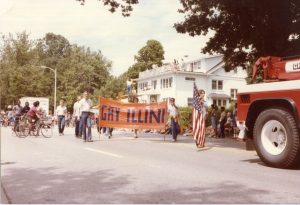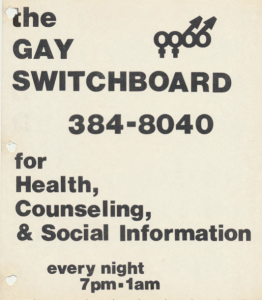Written by Chloe Attrell

The Stonewall Rebellion on June 28th, 1969 in New York City inspired queer people of various backgrounds to organize coalitions to combat discrimination, and advocate for civil rights in a time of intolerance and police brutality. This is the instance that many recall when Pride month comes around, as a singular, pivotal moment in history that defined much of the struggle to come. Nonetheless, it is just as important to consider the history of achievements made by local queer activists as well.
In the years following the rebellion, students and Champaign-Urbana residents sought to form queer rights advocacy groups. Jeffrey Graubart founded a Gay Liberation organization through the University in 1970, stressing the importance of heterosexual education on gay struggles as key in the advancement of gay rights [1]. Although this chapter disintegrated by 1973, those in the organization advocated against homophobic policy within the city and paved the way for other gay organizations to come.

The Gay Illini (initially called the Gay Students’ Alliance), founded in early 1975, became the central group for gay student concerns. Through collaborations with both the University and greater Champaign-Urbana area, they made significant achievements in their first two semesters of operation. The Gay Switchboard, established in fall of 1976, was among the GI’s most esteemed contributions. This Switchboard was a volunteer-run mental health hotline specifically for the gay community [2]. At this time, there had been no such resource for queer people in the area, making it a matter of urgency to have this hotline available. The number for the Switchboard came to be added to Urbana’s News-Gazette after representatives of the organization stressed its importance to local newspapers [3]. Additionally, they opened a Gay Resource Center in the University’s YWCA lounge by the end of 1975, where educational materials on sexuality were available to be checked out [4].
In addition to providing resources for queer students, the newly renamed Gay and Lesbian Illini advocated for an amendment to the University’s non-discrimination policy that would provide civil rights protections to queer students on campus, beginning in 1983. After two rejections from Chancellor Thomas Everhart, GLI responded with protests, including a sit-in in the Chancellor’s office. This response prompted Everhart to appoint a task force in 1986 to investigate the climate of queer student life and discrimination on campus [5]. By 1987, University policy began to change in favor of GLI’s goals.
The story of GLI’s fight for non-discrimination, visibility, and education, although important to the University’s history of civil rights, is only one aspect of LGBT life on campus and in Champaign-Urbana. Before and since their founding, queer students have existed and come together, and continue to do so today. To learn more about LGBT life on campus, The Office of Lesbian, Gay, Bisexual and Transgender Concerns Papers (RS 41/2/46) contains documentation of the history of queer student presence and activism. Joyce D. Meyer’s Papers (RS 41/20/271) additionally provides insight into Lesbian activism through the 1970s-1980s. Moreover, local newsletters like People Like Us and OUTpostings (RS 41/66/815; RS 41/66/816) are resources that provide insight into local queer culture and organization since the 1980s.
[1]-[4] 41/2/46 Box 2, Folder “Newspaper Clippings, 1970-1989 (1 of 4)”
[5] 41/66/815 Box 1, “People Like Us”